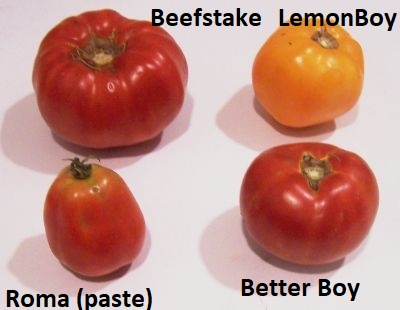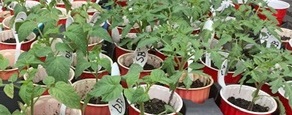
Looking for How to Grow Tomatoes in Your Yard or Patio - Everything you need to know in 2025? Scroll down this page and follow the links. And if you bring home some fruit or vegetables and want to can, freeze, make jam, salsa or pickles, see this page for simple, reliable, illustrated canning, freezing or preserving directions. There are plenty of other related resources, click on the resources dropdown above. If you are having a hard time finding canning lids, I've used these, and they're a great price & ship in 2 days.
If you have questions or feedback, please let me know! There are affiliate links on this page. Read our disclosure policy to learn more.
How to Grow Tomatoes in Your Yard or Patio - Everything you need to know
How to Grow Tomatoes in Your Yard or Patio - Everything you need to know
Homegrown taste SO much better than those store-bought lumps of bland chemical treated stuff.
They are easy to grow. Here's how and what you need to know.
- Varieties
There are many varieties, with many sizes, colors, flavors, growth heights, different levels of sweetness and acidity, heirloom varieties, hybrids with natural disease resistance.
Which is right for you? See this page for a Master List of Tomato varieties. It provides everything you could need and want to know about hundreds of varieties! If you want to make tomato sauce, see our Master List of Roma and Paste Tomato Varieties for the Home Garden
Or Master List of Heirloom Tomato Varieties and the
Master list of disease-resistant tomato varieties
The name "beefsteak tomato" comes from an 1869 seed catalog that described slices of a specialty tomato as being "as solid and meaty as a beefsteak". Beefsteak tomatoes are large, meaty tomatoes with a high ratio of flesh to juice and seeds, making them easy to slice and ideal for sandwiches. They usually weigh a pound or more and have a diameter of 5 inches or more
My favorites are a mix:
Cherokee Purple - heirloom with incredible flavor, but very susceptible to diseases
Better Boy - hybrid that is an excellent all round large tomato with very good diseases resistance
Honeycomb - Very sweet yellow cherry tomato
I'll create a page with many tomato varieties soon! - Plants or seeds?

A packet of 15 to 100 seeds typically costs about $2, depending on the variety and brand. A single plant costs about$4 to $6 now! If you start tomatoes from seeds, it's about 50 cents per plant. I prefer to start my own from seed. It's EASY - once you know the tricks. See this page - Temperatures
Tomatoes are warm-weather plants that grow best at temperatures between 70–85°F.
If you are starting tomatoes from seed, a thermostatic seed heating pad helps germination enormously! - Light
They need at least 6 to 8 hours of sunlight (preferably direct) per day. They WILL NOT do well in shade or partial shade. The more sun they get, the healthier the plants will be and the larger your harvest will be. - When to plant
Plant tomato plants after the risk of frost has passed in your area, from mid March in the Deep South to June in northern areas. In the South, you may want to plant a second grow in mid July, as the long season of heat and humidity kills the plants. - Garden, raised bed or containers?
Some people have success in containers, but I have always found it difficult and reduced yields. Very often the roots dry out or bake in the heat. Use the largest container you can get. Like 10 gallons of soil or more per plant.
Raised beds are great, if they are deep, because they drain well and usually allow for a deeper root system.
A garden is traditional and if the soil is good and well drain loam, you'll usually get huge yields with much less work than the previous two methods. - Soil
Soil pH should be only slightly acidic, between 6.0 and 6.8.
Work in organic matter like compost or well-rotted manure, especially if this is a new garden or the soil is sandy or heavy clay.
Work the compost, manure, leave, grass clippings or other organic matter as deep in the soil as you can and mix it well. - How to plant
Dig holes that are twice as wide as the root ball of your seedlings and about as deep as the length of the stem.
Remove any lower leaves that would be below ground.
Bury two-thirds of the stem to help it draw water from the soil. - Support
Always grow upwards! Use a fence, trellis or tomato cage.
Indeterminate varieties can easily grow 6 to 8 ft tall! - Fertilizing
Tomatoes need rich soil. Unless you have a well worked garden with huge amounts of aged manure, compost and organic matter worked into it over the years, you WILL need to add fertilizer, whether you prefer a home-made compost, poop from your own horse, fish emulsion tea, or 10-10-10 from Home Depot or MiracleGro. I prefer to work it into the ground with a rototiller before I plant and a few times during the growing season to sprinkle some MiracleGro on top of the mulch. - Mulch
Always use a mulch: Either 3 to 6 inches of grass clippings, straw, hay, straw, or shredded leaves OR weed fabric . Best is put organic compost down first then cover it with weed fabric on top. Mulching not only eliminates weeding, but also keeps soil moisture and temperature levels constant, and helps prevent diseases. - Watering
NEVER spray water onto the leaves, only on the ground without splashing. Soaker hoses are perfect. Standing water kills the plants, so if your soil is heavy, drain the water using a raised beds or planting on a slope. The plants should NEVER be standing in water. Good drainage is important. If it rains for 2 weeks and the water ponds up around the plants, it will kill them. Constantly wet plants also get and spread plant diseases.
How to save money and grow better tomatoes
Start you own tomatoes from seed! This year the Bonnie plants at Home Depot, Lowes and Walmart are selling for around $5 PER PLANT. That is INSANE! With my method you can grow your own for around 50- cents per plant!
You can also choose tastier and more disease resistant varieties. IT is SO easy - when you know these tips and tricks. See this page
Tomato Diseases and what to do about them
- See Tomato plant diseases - symptoms and what to do
- See this list of disease-resistant tomato varieties
References and more information
- Tomato Diseases and Disorders in the Home Garden from Penn State Extension
- Growing Tomatoes in the Home Garden Rutgers Cooperative Extension
- Growing Tomatoes Univ. of Maryland Extension
- Organic Gardening from the NC Extension Gardener Handbook
- Vegetable Gardening: a Beginner’s Guide NCSU AG-12
- Growing Tomatoes in Containers by Penn State Extension
- Excluding and Repelling Problem Wildlife from the Garden U of Mass, Amherst
- Epsom Salts: Miracle, Myth, or Marketing? WSU Extension PDF
- Soil Temperature Maps and interactive tools by location
- Watering the Vegetable Garden from Clemson
- Nematode Assay Forms and Information
Looking for canning equipment and supplies?
Water bath canner with a jar rack
Pressure canners for gas, electric and induction stoves: Presto 23Qt or T-fal 22Qt
Canning scoop (this one is PERFECT)
Ball Blue book (most recent version)
Jars: 8oz canning jars for jams
Find Other types of farms:
Farm markets and roadside stands
Road trips and camping resources
Local Honey, apiaries, beekeepers
Consumer fraud and scams information
Home canning supplies at the best prices on the internet!
Maple Syrup Farms, sugarworks, maple syrup festivals
Environmental information and resources
Farms For Your Event for birthday parties, weddings, receptions, business meetings, retreats, etc.
Festivals - local fruit and vegetable festivals
Get the
most recent version of
the Ball Blue Book
With this Presto 23 quart pressure canner and pressure cooker, you can "can" everything, fruits, vegetables, jams, jellies, salsa, applesauce, pickles, even meats, soups, stews. Model 01781

You can make jams, jellies, can fruit, applesauce, salsa and pickles with water bath canners, like this Granite Ware 12-Piece Canner Kit, Jar Rack, Blancher, Colander and 5 piece Canning Tool Set

